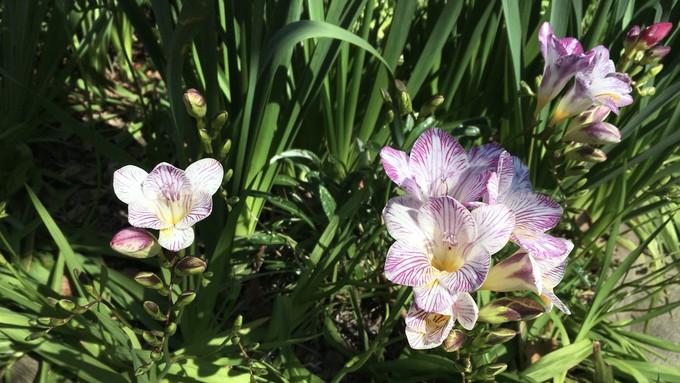
Expect more rain, but also some sunny gardening breaks

Freesias bloom in the sunshine. There's some rain in the next week's forecast, but the weather should be good for gardening most days. Kathy Morrison
Our rainy spring continues with more precipitation in the Sacramento forecast. According to the National Weather Service, March will wind up pretty much like it began – wet.
“Widespread moderate precipitation returns Monday PM – Wednesday,” tweeted the NWS Sacramento office on Saturday. “Heaviest precipitation is expected on Tuesday. Be prepared for slick roads, longer than normal commute, & possible ponding of water on roadways. Leave yourself extra time to travel!”
The weather service says Sacramento can expect another inch of rain from this latest storm. Leave the sprinklers off at least another week. So far this March, Sacramento has received 4.19 inches of rain, about 2 inches more than average.
Chilly temperatures will accompany those showers. The weather service issued a frost advisory for much of the Sacramento area for early Sunday morning; the anticipated low for Sacramento in the wee hours before dawn – 37 degrees. More frost danger is expected Monday with a low of 33 between 5 and 8 a.m.
Although not quite below freezing, those lows can still do damage to tender spring growth. And it’s awfully late to be this chilly; Sacramento’s historic frost date (the last day to expect frost danger) was Friday, March 24. Mother Nature isn’t listening; the weather service warns to expect “widespread frost before 8 a.m.” Sunday and Monday.
Sunny conditions return on Thursday, but temperatures will stay about 10 degrees (or more) below normal all week. Expected highs will hover around 60 degrees with lows dipping into the low 40s. Normal for Sacramento this week: highs of 71 and lows of 46.
So, tomato transplants will have to stay on hold a little longer. Meanwhile, concentrate on these tasks before or after this week’s rain:
* Fertilize roses, annual flowers and berries as spring growth begins to appear.
* Knock off aphids with a strong blast of water or some bug soap as soon as they appear.
* Pull weeds now! Don’t let them get started. Take a hoe and whack them as soon as they sprout.
* Prepare summer vegetable beds. Spade in compost and other amendments.
* Prune and fertilize spring-flowering shrubs after bloom.
* Feed camellias at the end of their bloom cycle. Pick up browned and fallen flowers to help corral blossom blight.
* Feed citrus trees, which are now in bloom and setting fruit.
To prevent sunburn and borer problems on young trees, paint the exposed portion of the trunk with diluted white latex (water-based) interior paint. Dilute the paint with an equal amount of cold water before application.
* Cut back and fertilize perennial herbs to encourage new growth.
* Seed and renovate the lawn (if you still have one). Feed cool-season grasses such as bent, blue, rye and fescue with a slow-release fertilizer. Check the irrigation system and perform maintenance. Make sure sprinkler heads are turned toward the lawn, not the sidewalk.
* In the vegetable garden, transplant lettuce and kale.
* Seed chard and beets directly into the ground.
* Plant summer bulbs, including gladiolus, tuberous begonias and callas. Also plant dahlia tubers.
* Shop for perennials. Many varieties are available in local nurseries and at plant events. They can be transplanted now while the weather remains relatively cool.
Comments
0 comments have been posted.Sacramento Digs Gardening to your inbox.
Sites We Like
Garden Checklist for week of July 21
Your garden needs you!
* Keep your vegetable garden watered, mulched and weeded. Water before 8 a.m. to reduce the chance of fungal infection and to conserve moisture.
* Feed vegetable plants bone meal, rock phosphate or other fertilizers high in phosphate to stimulate more blooms and fruiting. (But wait until daily high temperatures drop out of the 100s.)
* Don’t let tomatoes wilt or dry out completely. Give tomatoes a deep watering two to three times a week.
* Harvest vegetables promptly to encourage plants to produce more. Squash especially tends to grow rapidly in hot weather. Keep an eye on zucchini.
* Pinch back chrysanthemums for bushy plants and more flowers in September.
* Remove spent flowers from roses, daylilies and other bloomers as they finish flowering.
* Pinch off blooms from basil so the plant will grow more leaves.
* Cut back lavender after flowering to promote a second bloom.
* It's not too late to add a splash of color. Plant petunias, snapdragons, zinnias and marigolds.
* From seed, plant corn, pumpkins, radishes, winter squash and sunflowers.